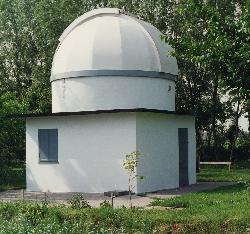
Giuseppe Piazzi was an Italian Catholic priest of the Theatine order, mathematician, and astronomer. He established an observatory at Palermo, now the Osservatorio Astronomico di Palermo – Giuseppe S. Vaiana. He is perhaps most famous for his discovery of the first dwarf planet, Ceres.

Stefano Sposetti is a Swiss amateur astronomer and a prolific discoverer of minor planets. He lives in Gnosca, in the Italian-speaking part of Switzerland in the Ticino Alps, where the Gnosca Observatory is located.
Piero Sicoli is an Italian astronomer and discoverer of minor planets, observing at the Italian Sormano Astronomical Observatory. As the observatory's coordinator, he is responsible for close encounters computation of near-Earth objects (NEOs), orbit computations, and identification of asteroids. The Observatory's focus is the examination and tracking of NEOs in Solar System.
Marco Cavagna was an Italian amateur astronomer.
Vincenzo Zappalà is an Italian astronomer and discoverer of several main-belt asteroids.

The Santa Lucia Stroncone Astronomical Observatory is an astronomical observatory located at 350 metres (1,150 ft) altitude in Stroncone, near the city of Terni, in Umbria, north central Italy.
Giovanni de Sanctis is an Italian astronomer and discoverer of minor planets at the Osservatorio Astronomico di Torino in Turin, Italy. His name is sometimes spelt DeSanctis, particularly in the Minor Planet Circulars. The Minor Planet Center credits him with the discovery of 42 numbered minor planets, most of which he discovered at ESO's La Silla site in northern Chile in the early 1980s.

Bassano Bresciano is a comune in the province of Brescia, in Lombardy. As of 2011 Bassano Bresciano had a population of 2,237.
Aldo Di Clemente is an Italian amateur astronomer. He has worked as a technician at the Campo Imperatore station of the Osservatorio astronomico di Roma since 1982. His assistance was valuable in conducting the Campo Imperatore Near-Earth Object Survey (CINEOS).

The Pistoia Mountains Astronomical Observatory, also known as the San Marcello Observatory and the Pian dei Termini Observatory, is an astronomical observatory in San Marcello Piteglio, Tuscany, central Italy.

Pino Torinese is a comune (municipality) in the Metropolitan City of Turin in the Italian region Piedmont, located about 6 kilometres (4 mi) southeast of Turin.

The National Institute for Astrophysics is an Italian research institute in astronomy and astrophysics, founded in 1999. INAF funds and operates twenty separate research facilities, which in turn employ scientists, engineers and technical staff. The research they perform covers most areas of astronomy, ranging from planetary science to cosmology.

1107 Lictoria is a large Hygiea asteroid, approximately 79 kilometers in diameter, from the outer regions of the asteroid belt. It was discovered by Luigi Volta at the Pino Torinese Observatory in 1929, and named after the Fasces Lictores, Latin for "Fasci Littori", the symbol of the Italian fascist party.
1115 Sabauda is a carbonaceous Meliboean asteroid from the outer region of the asteroid belt, approximately 68 kilometers in diameter. Discovered in 1928 by Italian astronomer Luigi Volta, it was assigned the provisional designation 1928 XC. The asteroid was probably named after the House of Savoy, the former rulers of Italy.

The Gnosca Observatory is an astronomical observatory at Gnosca, Ticino, Switzerland. It is owned and operated by amateur astronomer Stefano Sposetti and has the observatory code 143. At Gnosca Observatory, Stefano Sposetti has discovered numerous minor planets (also see Category:Discoveries by Stefano Sposetti).

1218 Aster, provisional designation 1932 BJ, is a bright asteroid from the inner regions of the asteroid belt, approximately 5.5 kilometers in diameter. Discovered by Karl Reinmuth in 1932, it was later named after the flowering plant Aster.

1332 Marconia, provisional designation 1934 AA, is a dark asteroid and the parent body of the Marconia family located in the outer regions of the asteroid belt. It measures approximately 46 kilometers in diameter. The asteroid was discovered on 9 January 1934, by Italian astronomer Luigi Volta at the Observatory of Turin in Pino Torinese, northern Italy. It was named for Italian electrical engineer Guglielmo Marconi. The uncommon L-type asteroid has a rotation period of 19.2 hours.
1238 Predappia, provisional designation 1932 CA, is a dark Adeonian asteroid from the central regions of the asteroid belt, approximately 21 kilometers in diameter. It was discovered on 4 February 1932, by astronomer Luigi Volta at the Observatory of Turin in Pino Torinese, Italy. It was later named after the Italian village of Predappio.
Walter Ferreri, originally from Buddusò in Sardinia, is an astronomer at the Italian Osservatorio Astronomico di Torino, science writer and discoverer of minor planets.











